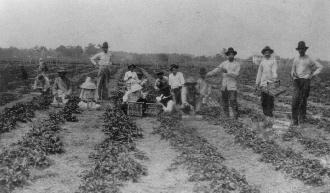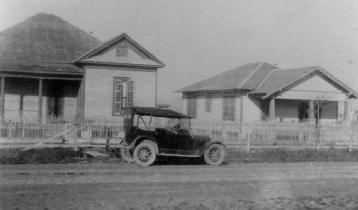Frequently Asked Questions about the History of Pasadena,
Texas
- 1. Did they really grow strawberries in Pasadena?

- Absolutely yes. The small farming community of Pasadena grew
a little bit of everything in the beginning. But when Clara Barton
of the American Red Cross introduced 1.5 million strawberry plants
into the area after the great Galveston Hurricane of 1900, Pasadena
farmers discovered a new, and very profitable crop. And, it did
not replace any of the other crops that were being grown in the
community. The small family plots grew each year and by the 1920s
large farms, with imported workers, filled the refrigerated boxcars
lined up at the Pasadena railroad depot. The entire southeast
area of Harris County became known as "Pasadena Acres"
for all of the strawberries grown in the area. Strawberries disappeared
during the community's shift to an industrial based economy during
World War II. Strawberry farming began as a small family operation
in the early 1900s but grew quickly. As the industry grew migratory
workers were brought in to assist with the picking. Soon many
of those seasonal pickers became permanent residents as the economy
continued to grow.
- 2. Where did the name "Pasadena" come from?
-
- Charles Munger was engaged to develope the new community
known as the townsite of the Deepwater Land and Town Company.
When Charles told his family back in Kansas about the beautiful
land they were going to, his twelve year old daughter, Edith,
thought they were going to Pasadena, California. Charles adopted
the name, Pasadena, for the new community in Texas. The name,
Pasadena, is a Chippewa (Ojibway) Indian word meaning, "Crown
of the Valley."
-
- 3. Who was the first mayor of Pasadena?
-
- That might be a trick question. Actually, you could say that
Pasadena had two "first" mayors. The community voted
to incorporate on December 22, 1923. Ralph E. Parks was elected
mayor. However, the community drew its incorporation limits to
take in some of the new industries along the Houston Ship Channel.
Houston got upset and called for action by the State Attorney
General. With flaming editorials and headlines that read "Greedy
Village" the city decided to unincorporate and save the
expense of a legal battle. After fighting off an annexation drive
by Houston, the little community voted to reincorporate on December
26, 1928. Gerald Conrad served as the interim mayor before being
elected to that office on April 2, 1929.
-
- 4. What is the Pasadena
Heritage Park and the Pomeroy Homestead
Museum?
-
- The Pomeroy family donated their family homeplace to the
City of Pasadena for historical museum purposes in December,
1986. This donation included two houses, two garages, one outhouse
and nine city lots. Using Hotel-Motel tax money, the city is
renovating the property for museum purposes. The property is
now designated as the Pasadena Heritage Park and will
include three interpretives structures and a new main museum
facility. The W. S. Park's "Strawberry House"
was moved to the property in 2002 and the museum holdings will
moved to a new modern facility for interpretation and preservation.
A Master Plan was approved in 1999. The first phase of the Park
opened in June 2000.
-
 The Pomeroy Homestead
at 204 S. Main in Pasadena ihas been restored for use as museum
properties. The house on the left was built in 1908 and will be
restored to the 1935-45 time period to represent the transition
of the community from a farming economy to an industrial one during
World War II. The house on the right was built about 1923 as the
"mother-in-law" house for Anna Louise Pomeroy.
The Pomeroy Homestead
at 204 S. Main in Pasadena ihas been restored for use as museum
properties. The house on the left was built in 1908 and will be
restored to the 1935-45 time period to represent the transition
of the community from a farming economy to an industrial one during
World War II. The house on the right was built about 1923 as the
"mother-in-law" house for Anna Louise Pomeroy.
Mapquest location map Use
the back button to return to this page,
-
5. How many years of school did a child have to complete
in order to get a school diploma?
In the early 1990s a student in Pasadena only had to go to
school for seven grades and then they would get a certificate.
A student could then go to "normal" school and get
a teaching certificate after a semester of training. Thus teachers
were sometimes just barely older than their students. As the
demand for more education developed, a two year "high school"
diploma could be earned and then a "four year" high
school diploma would be earned above that. This was much like
the two year "associate" degree you can get today from
a community college and then a four year "college degree"
for an additional two years of work at a state level college.
A few of the Pasadena students began wanting more education than
the seven years and Pasadena tried to provide a couple more years.
Ultimately students wanting more than the seven years went to
high school in Harrisburg. Although they got their diploma from
Harrisburg, they stuck together and considered themselves Pasadena
graduates. By 1920 the Pasadena Independent School system decided
to commit to a high school program and the building was dedicated
on December 17, 1924. This provided an additonal four years of
education in Pasadena, making a total of eleven years of formal
schooling. The old Pasadena School was renamed the Pasadena Grammar
School (later Kruse Elementary). By the 1930s the student population
had increased so much that Pasadena decided to open an intermediate
school for grades between grammar and high school. Jackson Junior
High opened in 1937 although junior high classes had been established
earlier and were being taught in the Grammer school building.
In 1939 the state began requiring an additional year of education
for certification and then twelve years became the required course
of study in order to get a degree. The Class of 1940 had the
option of getting a degree after eleven years, or sticking around
for another year and then getting it for twelve years of work.
A lot of the football players stuck it out an additional year
in order to play football one more year. But don't laugh at those
old grammar school certificate educations. Try out the final
exam they took in the eight grade in Kansas.
Tune in later for more questions and answers...or send in a
question of your own!
5.22.06


 The Pomeroy Homestead
at 204 S. Main in Pasadena ihas been restored for use as museum
properties. The house on the left was built in 1908 and will be
restored to the 1935-45 time period to represent the transition
of the community from a farming economy to an industrial one during
World War II. The house on the right was built about 1923 as the
"mother-in-law" house for Anna Louise Pomeroy.
The Pomeroy Homestead
at 204 S. Main in Pasadena ihas been restored for use as museum
properties. The house on the left was built in 1908 and will be
restored to the 1935-45 time period to represent the transition
of the community from a farming economy to an industrial one during
World War II. The house on the right was built about 1923 as the
"mother-in-law" house for Anna Louise Pomeroy.